Reconstruction of a Two-Dimensional Blocking Index During the Last Four Hundred Years Using Gridded Temperature and Precipitation Data
Abstract
1. Introduction
2. Data and Methods
2.1. Blocking Index Calculation
2.2. Gridded Datasets for Predictor Selection
2.3. Climate Index Reconstructions
2.4. Methods
3. Results
3.1. Blocking Reconstruction Based on Observational Data
3.2. Blocking Reconstruction Based on Paleo-Reanalysis Data
4. Discussion and Conclusions
Author Contributions
Funding
Data Availability Statement
Acknowledgments
Conflicts of Interest
References
- Kautz, L.A.; Martius, O.; Pfahl, S.; Pinto, J.G.; Ramos, A.M.; Sousa, P.; Woollings, T. Atmospheric blocking and weather extremes over the Euro-Atlantic sector—A review. Weather Clim. Dyn. Discuss. 2022, 3, 305–336. [Google Scholar] [CrossRef]
- Voskresenskaya, E.N.; Kovalenko, O.Y. Blocking Anticyclones in the European Region and Their Variability Associated with El Nino Events. Izv. Ross. Akad. Nauk. Seriya Geogr. 2016, 1, 49–57. [Google Scholar] [CrossRef][Green Version]
- Hakkinen, S.; Rhines, P.B.; Worthen, D.L. Atmospheric blocking and Atlantic multidecadal ocean variability. Science 2011, 334, 655–659. [Google Scholar] [CrossRef]
- Rimbu, N.; Lohmann, G.; Ionita, M. Interannual to multidecadal Euro-Atlantic blocking variability during winter and its relationship with extreme low temperatures in Europe. J. Geopys. Res. Atmos. 2014, 119, 13,621–13,636. [Google Scholar] [CrossRef]
- Wazneh, H.; Gachon, P.; Laprise, R.; de Vernal, A.; Tremblay, B. Atmospheric blocking events in the North Atlantic: Trends and links to climate anomalies and teleconnections. Clim. Dyn. 2021, 56, 2199–2221. [Google Scholar] [CrossRef]
- Saarni, F.; Muschitiella, F.; Weege, S.; Brauer, A.; Saarinen, T. A late Holocene record of solar-forced atmospheric blocking variability over Northern Europe inferred from varved lake sediments of Lake Kuninkaisenlampi. Quat. Sci. Rev. 2016, 154, 100–110. [Google Scholar] [CrossRef]
- Hu, H.M.; Shen, C.C.; Chiang, J.; Trouet, V.; Michel, V.; Tsai, H.C.; Valensi, P.; Spötl, C.; Starnini, E.; Zunino, M.; et al. Split westerlies over Europe in the early Little Ice Age. Nat. Commun. 2022, 13, 4898. [Google Scholar] [CrossRef] [PubMed]
- Lapointe, F.; Karmalkar, A.V.; Bradley, R.S.; Retelle, M.J.; Wang, F. Climate extremes in Svalbard over the last two millennia are linked to atmospheric blocking. Nat. Commun. 2024, 15, 4432. [Google Scholar] [CrossRef]
- Lohmann, R.; Purr, C.; Ahrens, B. Northern Hemisphere atmospheric blocking in CMIP6 climate projections using a hybrid index. J. Clim. 2024, 37, 6605–6617. [Google Scholar] [CrossRef]
- Karamperiodu, C. Extracting paleoweather from paleoclimate through a deep learning reconstruction of last millennium atmospheric blocking. Commun. Earth Environ. 2024, 5, 5535. [Google Scholar] [CrossRef]
- Lohmann, G.; Rimbu, N.; Dima, M. Where can the Arctic oscillation be reconstructed? Towards a reconstruction of climate modes based on stable teleconnections. Clim. Past. Discuss. 2005, 1, 17–56. [Google Scholar] [CrossRef]
- Ionita, M.; Lohmann, G.; Rimbu, N. Prediction of Spring Elbe Discharge Based on Stable Teleconnections with Winter Global Temperature and Precipitation. J. Clim. 2008, 21, 6215–6226. [Google Scholar] [CrossRef]
- Scherrer, S.; Croci-Maspoli, M.; Schwierz, C.; Appenzeller, A. Two-dimensional indices of atmospheric blocking and their statistical relationship with winter climate patterns in the Euro-Atlantic region. Int. J. Climatol. 2006, 26, 233–249. [Google Scholar] [CrossRef]
- Tibaldi, S.; Molteni, F. On the operational predictability of blocking. Tellus A 1990, 42, 343–365. [Google Scholar] [CrossRef]
- Davini, P.; Cagnazzo, C.; Gualdi, S.; Navarra, A. Bidimensional diagnostics, variability and trends of Northern Hemisphere blocking. J. Clim. 2012, 25, 6496–6509. [Google Scholar] [CrossRef]
- Gelaro, R.; McCarty, W.; Suárez, M.J.; Todling, R.; Molod, A.; Takacs, L.; Randles, C.A.; Darmenov, A.; Bosilovich, M.C.; Reichle, R.; et al. The Modern Eran Retrospective Analysis for Research and Applications, version 2 (MERRA-2). J. Clim. 2017, 30, 5419–5454. [Google Scholar] [CrossRef]
- Rustemeier, E.; Hänsel, S.; Finger, P.; Schneider, U.; Ziese, M. GPCC Climatology Version 2022 at 2.5°: Monthly Land-Surface Precipitation Climatology for Every Month and the Total Year from Rain-Gauges Built on GTS-Based and Historical Data. 2022. Available online: https://opendata.dwd.de/climate_environment/GPCC/html/gpcc_normals_v2022_doi_download.html (accessed on 15 October 2024).
- Vose, R.S.; Huang, B.; Yin, X.; Arndt, D.; Easterling, D.R.; Lawrimore, J.H.; Menne, M.J.; Sanchez-Lugo, A.; Zhang, H.M. Implementing Full Spatial Coverage in NOAA’s Global Temperature Analysis. Geophys. Res. Lett. 2021, 48, e2020GL090873. [Google Scholar] [CrossRef]
- Valler, V.; Franke, J.; Brugnara, Y.; Broenimann, S. An updated global atmospheric paleo-reanalysis covering the last 400 years. Geosci. Data J. 2022, 9, 89–107. [Google Scholar] [CrossRef]
- Tardiff, R.; Hakim, W.; Perkins, G.J.; Horlick, K.A.; Erb, M.P.; Emile-Geay, J.; Anderson, D.M.; Steig, E.J.; Noone, D. Last Millennium Reanalysis with an expanded proxy database and seasonal proxy modeling. Clim. Past. 2019, 15, 1251–1273. [Google Scholar] [CrossRef]
- Ortega, O.; Lehner, F.; Swingedouw, D.; Masson-Delmotte, V.; Raible, C.C.; Casado, M.; Yiou, P. A model-tested North Atlantic Oscillation reconstruction for the past millennium. Nature 2015, 523, 71–74. [Google Scholar] [CrossRef]
- Cook, E.R.; Kushnir, Y.; Smerdon, J.E.; Williams, A.P.; Anchukaitis, K.J.; Wahl, E.R. A Euro-Mediterranean tree-ring reconstruction of the winter NAO index since 910 CE. Clim. Dyn. 2019, 53, 1567–1580. [Google Scholar] [CrossRef]
- Luterbacher, J.; Xoplaki, E.; Dietrich, D.; Jones, P.D.; Portis, D.; Gonzales-Rouco, J.F.; von Storch, H.; Gyalistras, D.; Casty, C.; Wanner, H.; et al. Extending North Atlantic oscillation reconstructions back to 1500. Atmos. Sci. Lett. 2000, 2, 114–124. [Google Scholar] [CrossRef]
- Gomez-Navarro, J.J.; Werner, J.; Wagner, S.; Luterbacher, J.; Zorita, E. Establishing the skill of climate field reconstruction techniques for precipitation with pseudoproxy experiments. Clim. Dyn. 2015, 45, 1395–1413. [Google Scholar] [CrossRef]
- Zhang, Z.; Wagner, S.; Klockmann, M.; Zorita, E. Evaluation of statistical climate reconstruction methods based on pseudoproxy experiments using linear and machine-learning methods. Clim. Past. 2022, 18, 2643–2668. [Google Scholar] [CrossRef]
- von Storch, H.; Zwiers, F. Statistical Analysis in Climate Research; Cambridge University Press: Cambridge, UK, 1999. [Google Scholar]
- Kalnay, E.; Kanamitsu, M.; Kistler, R.; Collins, W.; Deaven, D.; Gandin, L.; Iredell, M.; Saha, S.; White, G.; Woolen, J. The NCEP/NCAR 40-Year Reanalysis Project. Bull. Am. Meteorol. Soc. 1996, 77, 437–471. Available online: https://journals.ametsoc.org/view/journals/bams/77/3/1520-0477_1996_077_0437_tnyrp_2_0_co_2.xml (accessed on 15 May 2024). [CrossRef]
- Slivinski, L.C.; Compo, G.P.; Whitaker, J.S.; Sardeshmukh, P.D.; Giese, B.S.; McColl, C.; Allan, R.; Yin, X.; Vose, R.; Titchner, H.; et al. Towards a more reliable historical reanalysis: Improvements for version 3 of the Twentieth Century Reanalysis system. Q. J. R. Meteorol. Soc. 2019, 145, 2876–2908. [Google Scholar] [CrossRef]
- Brönnimann, S. From climate to weather reconstructions. PLoS Clim. 2022, 1, e0000034. [Google Scholar] [CrossRef]
- Brönnimann, S.; Filipiak, J.; Chen, S.; Pfister, L. The weather of 1740, the coldest year in central Europe in 600 years. Clim. Past. 2024, 20, 2219–2235. [Google Scholar] [CrossRef]
- Ghershunov, A.; Schneider, N.; Barnett, T. Low-Frequency Modulation of the ENSO–Indian Monsoon Rainfall Relationship: Signal or Noise? J. Clim. 2001, 14, 2486–2492. [Google Scholar] [CrossRef]
- Sterl, A.; van Oldenborgh, G.J.; Hazeleger, W.; Burgers, G. On the robustness of ENSO teleconnections. Clim. Dyn. 2007, 29, 469–485. [Google Scholar] [CrossRef][Green Version]
- Brönnimann, S.; Franke, J.; Valler, V.; Hand, R.; Samakinwa, E.; Lundstad, E.; Burgdorf, A.M.; Lipfert1, L.; Pfister, L.; Imfeld, N.; et al. Past hydroclimate extremes in Europe driven by Atlantic jet stream and recurrent weather patterns. Nat. Geosci. 2025, 18, 246–253. [Google Scholar] [CrossRef] [PubMed]
- Lupo, R.L. Atmospheric blocking events: A review. Ann. N. Y. Acad. Sci. 2021, 1504, 5–24. [Google Scholar] [CrossRef]
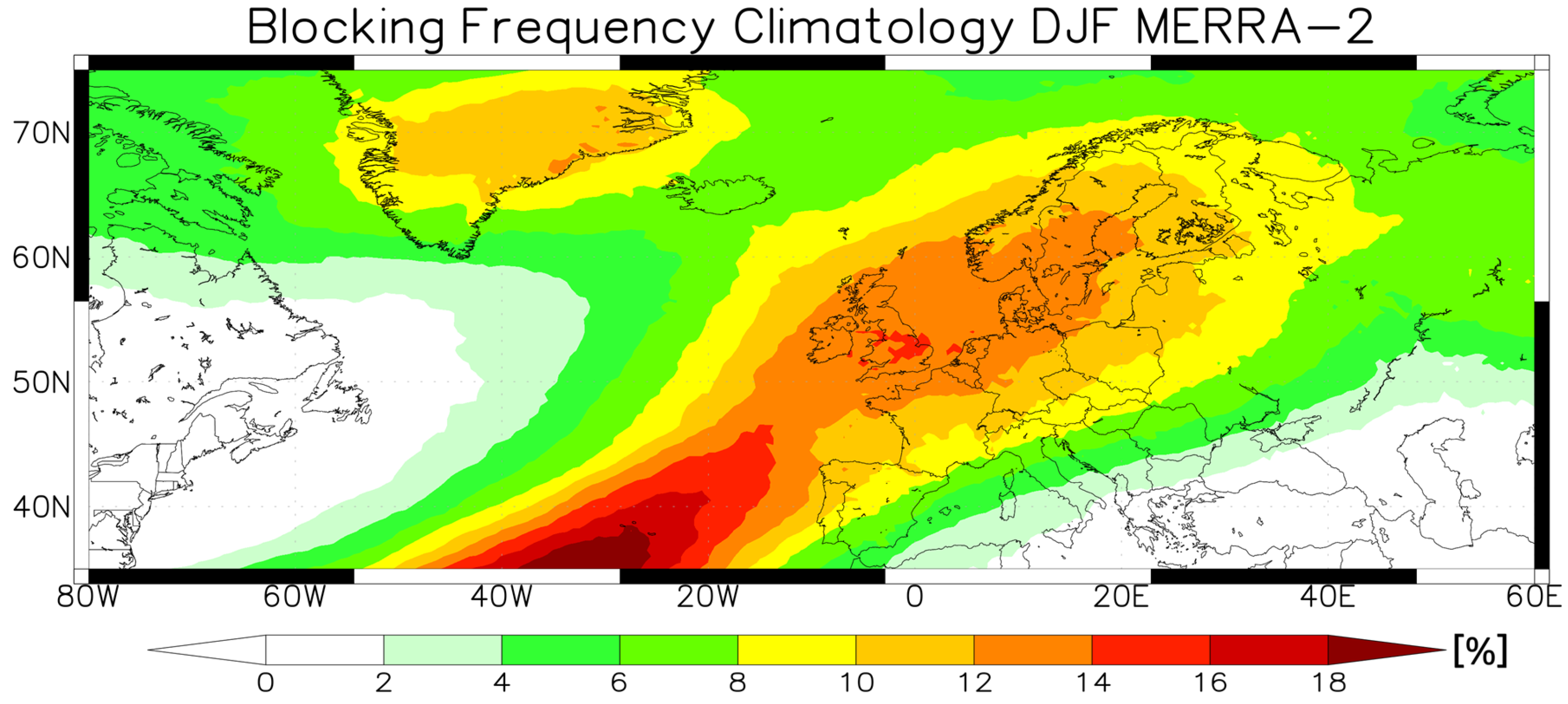
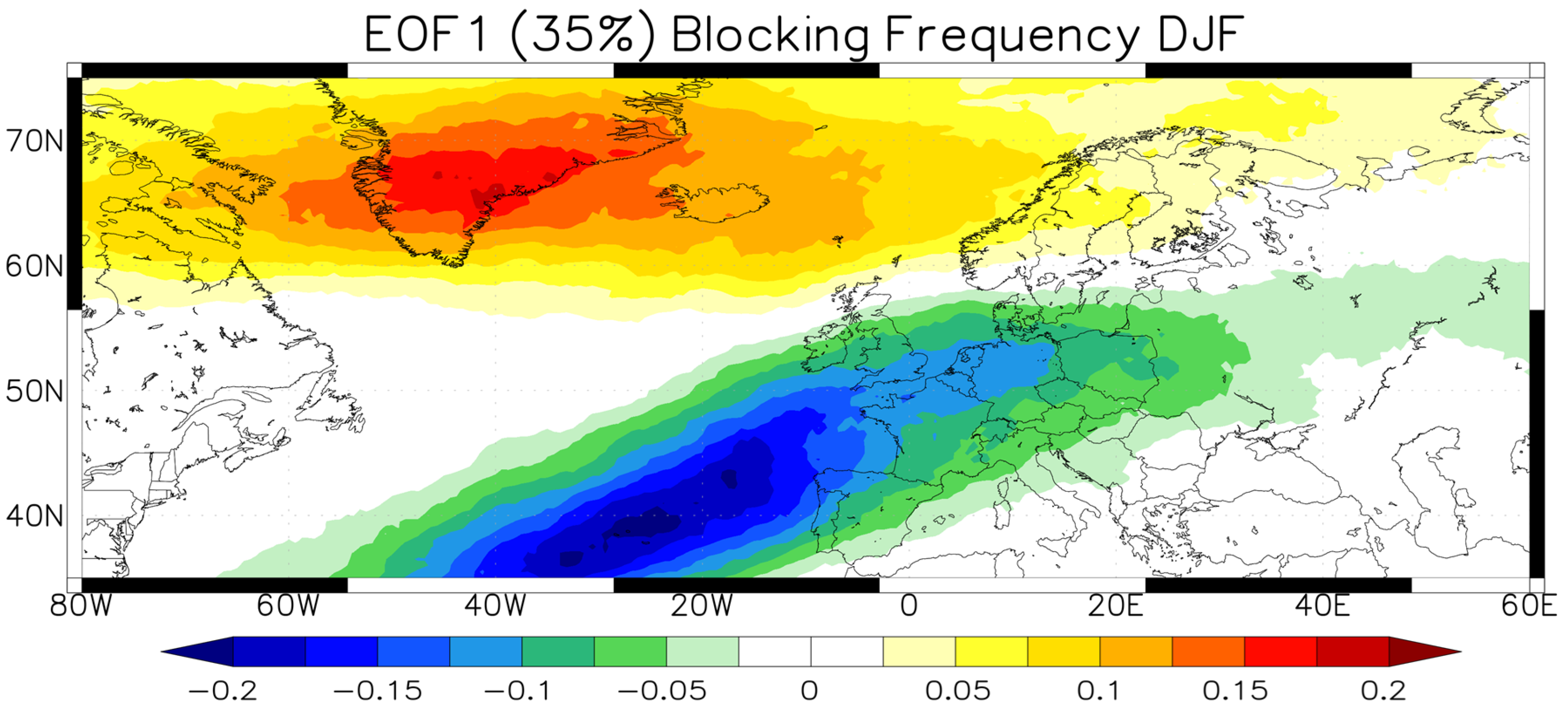
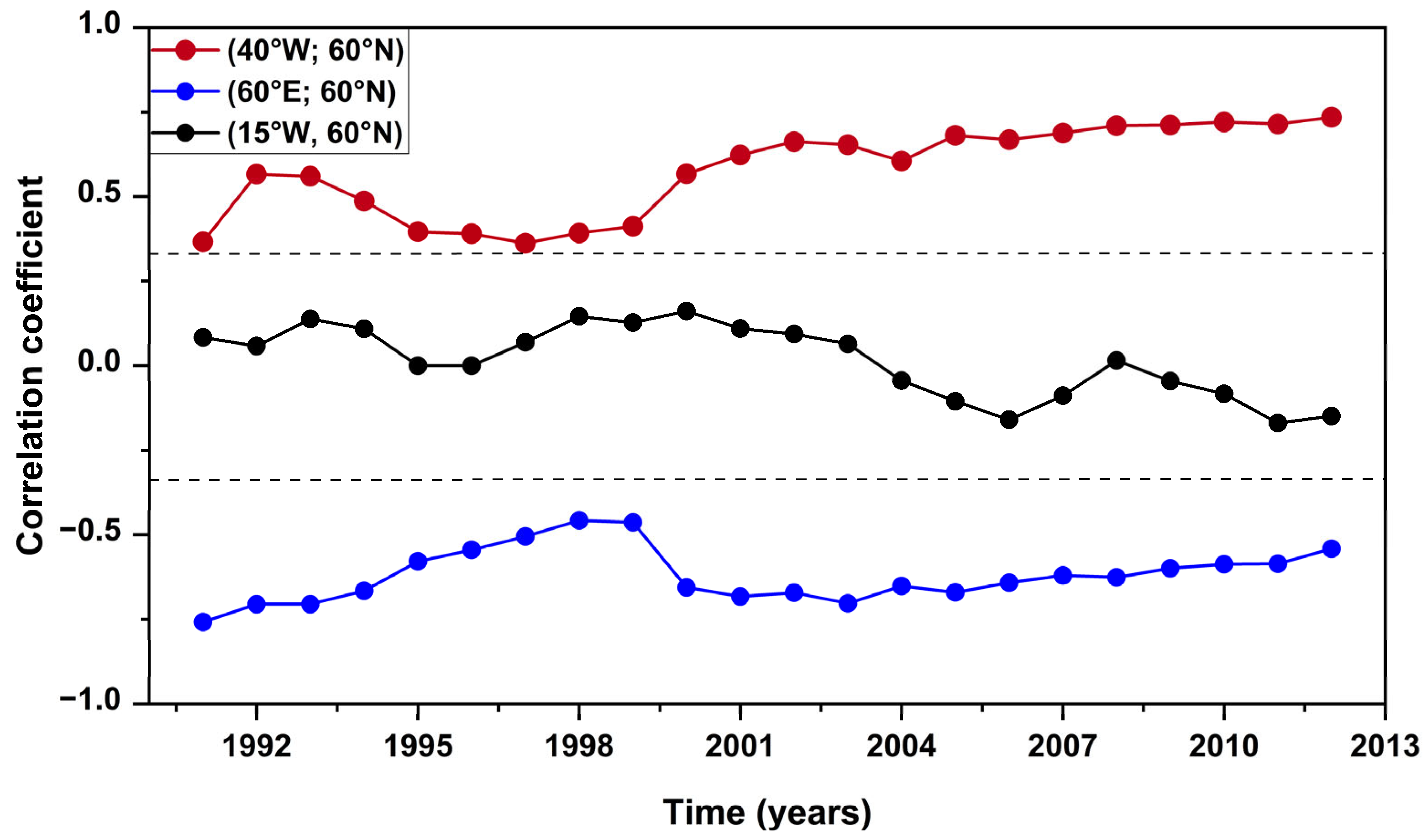
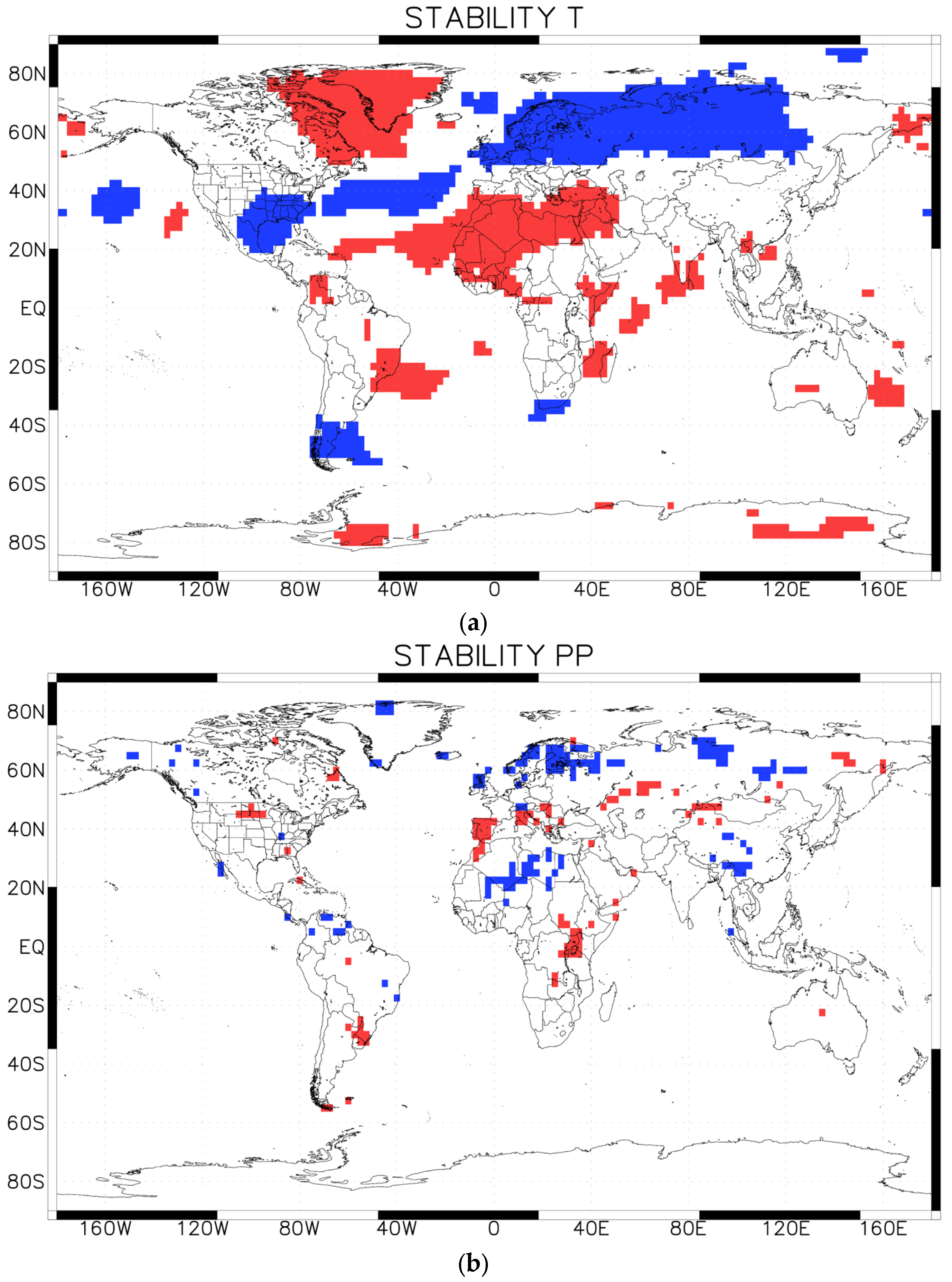
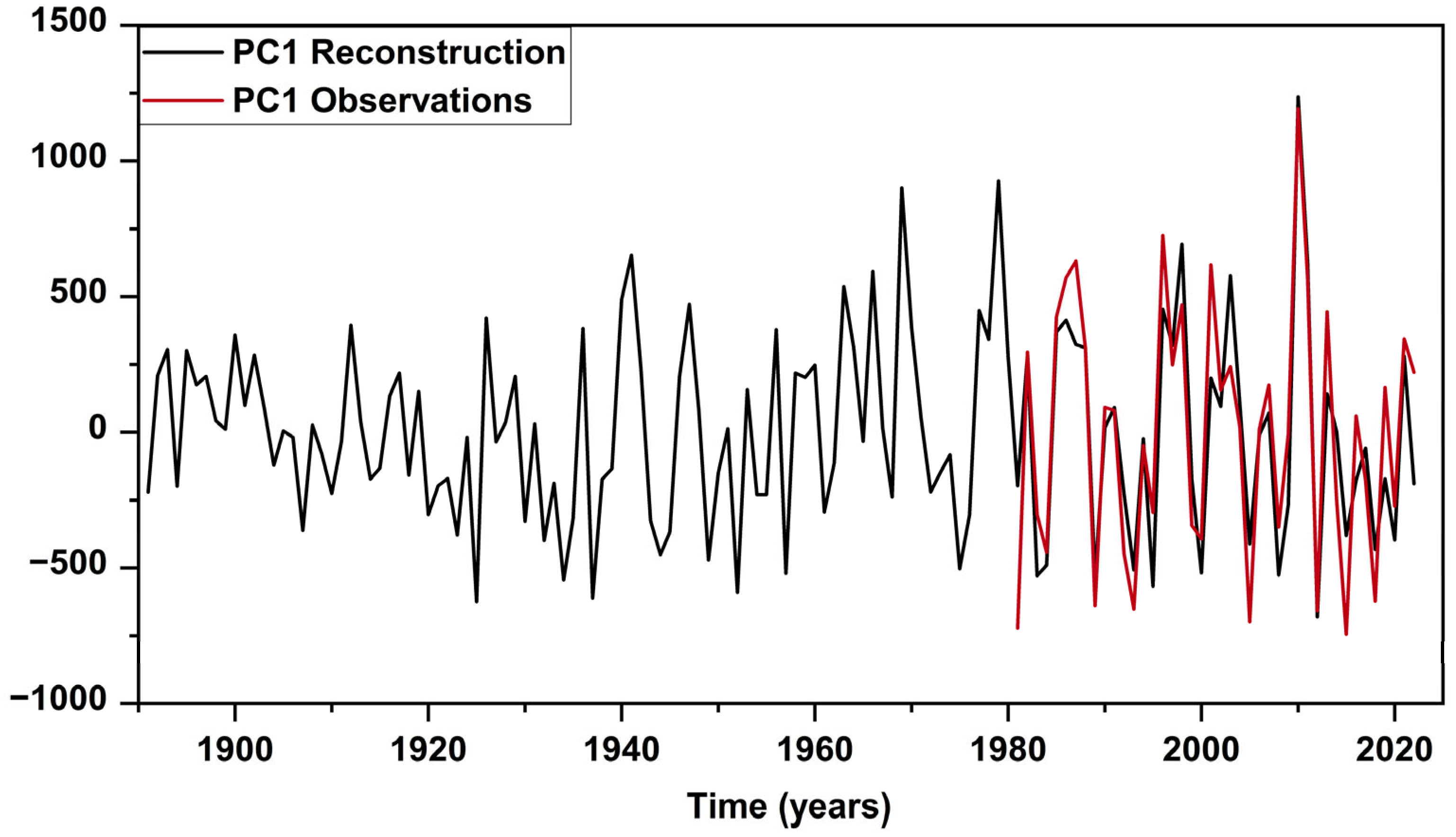
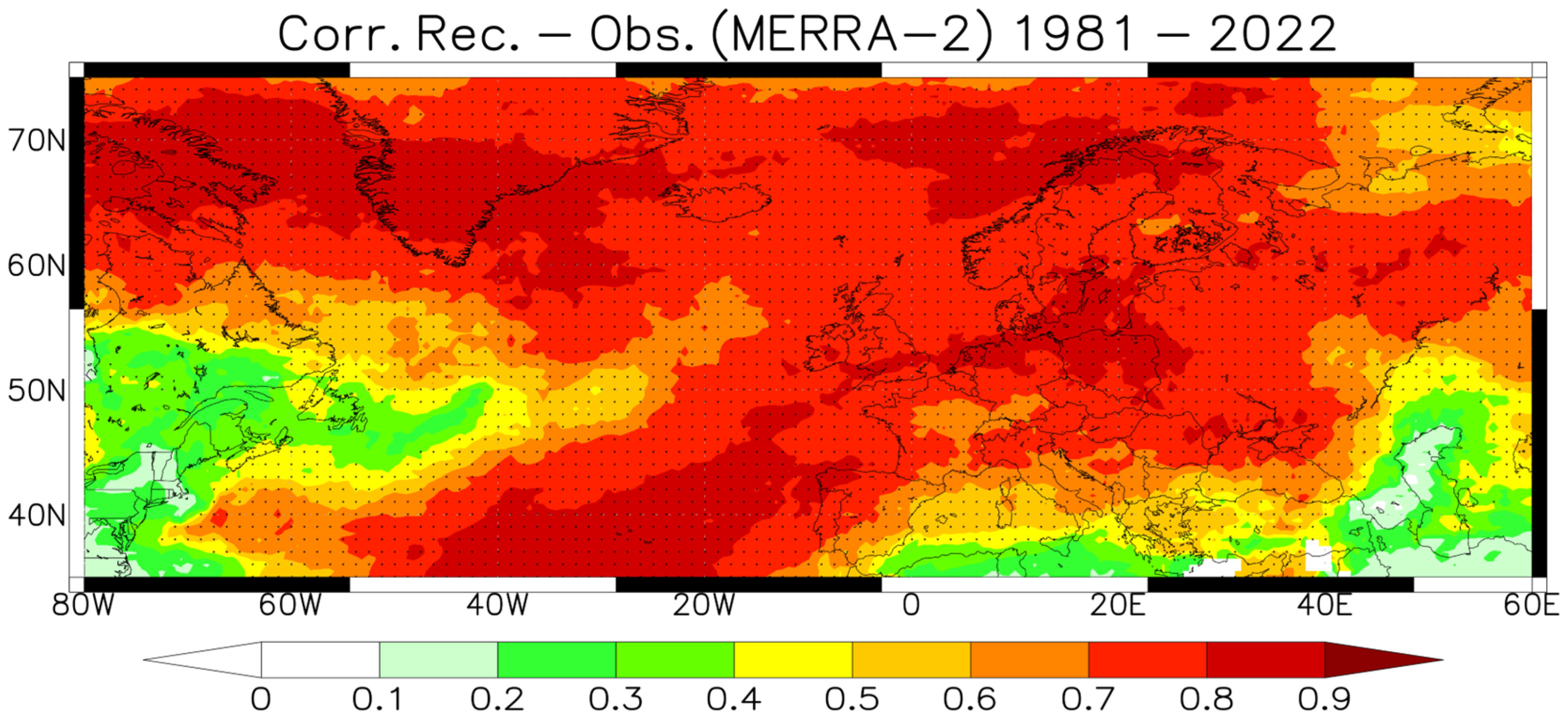
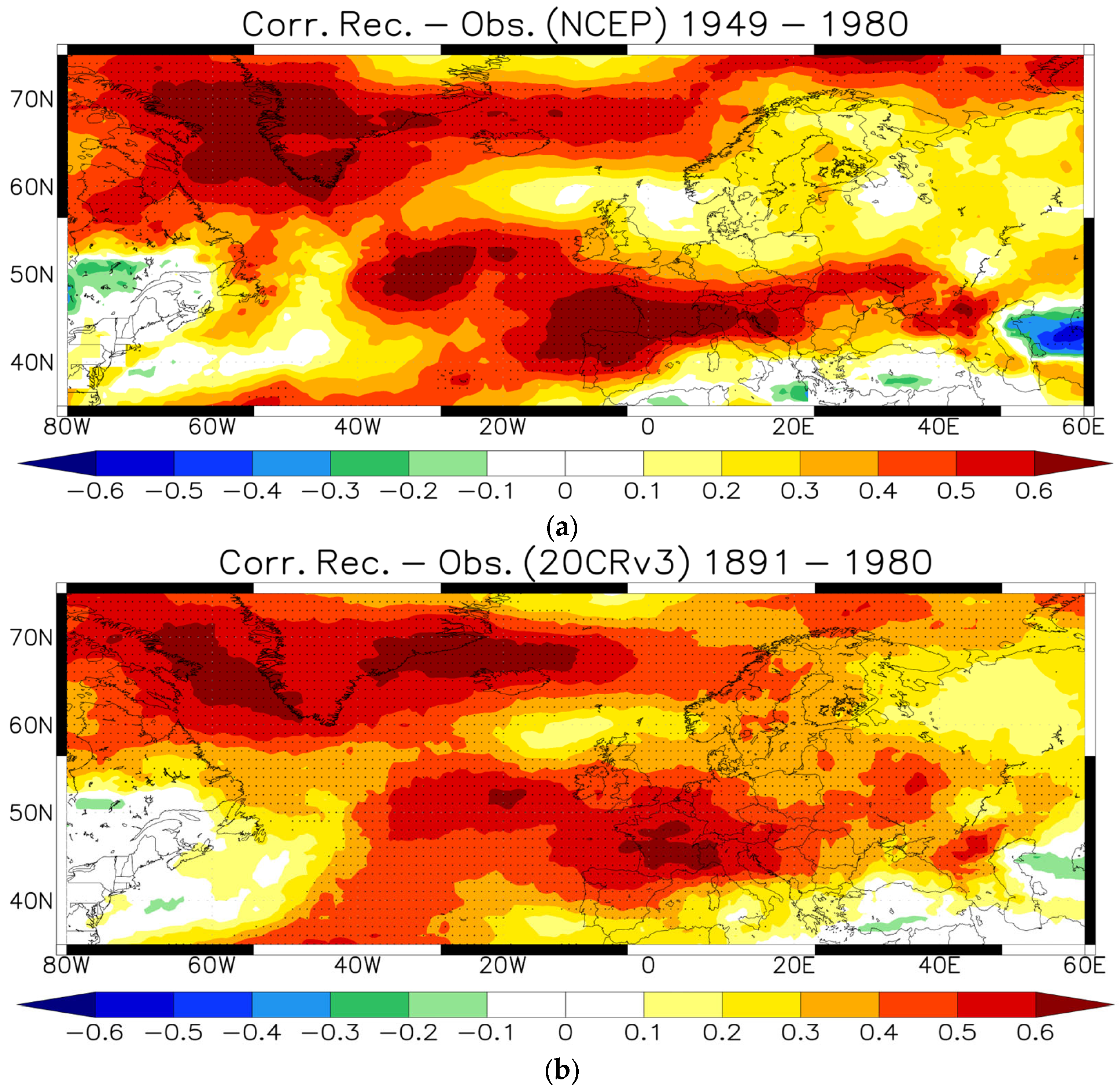
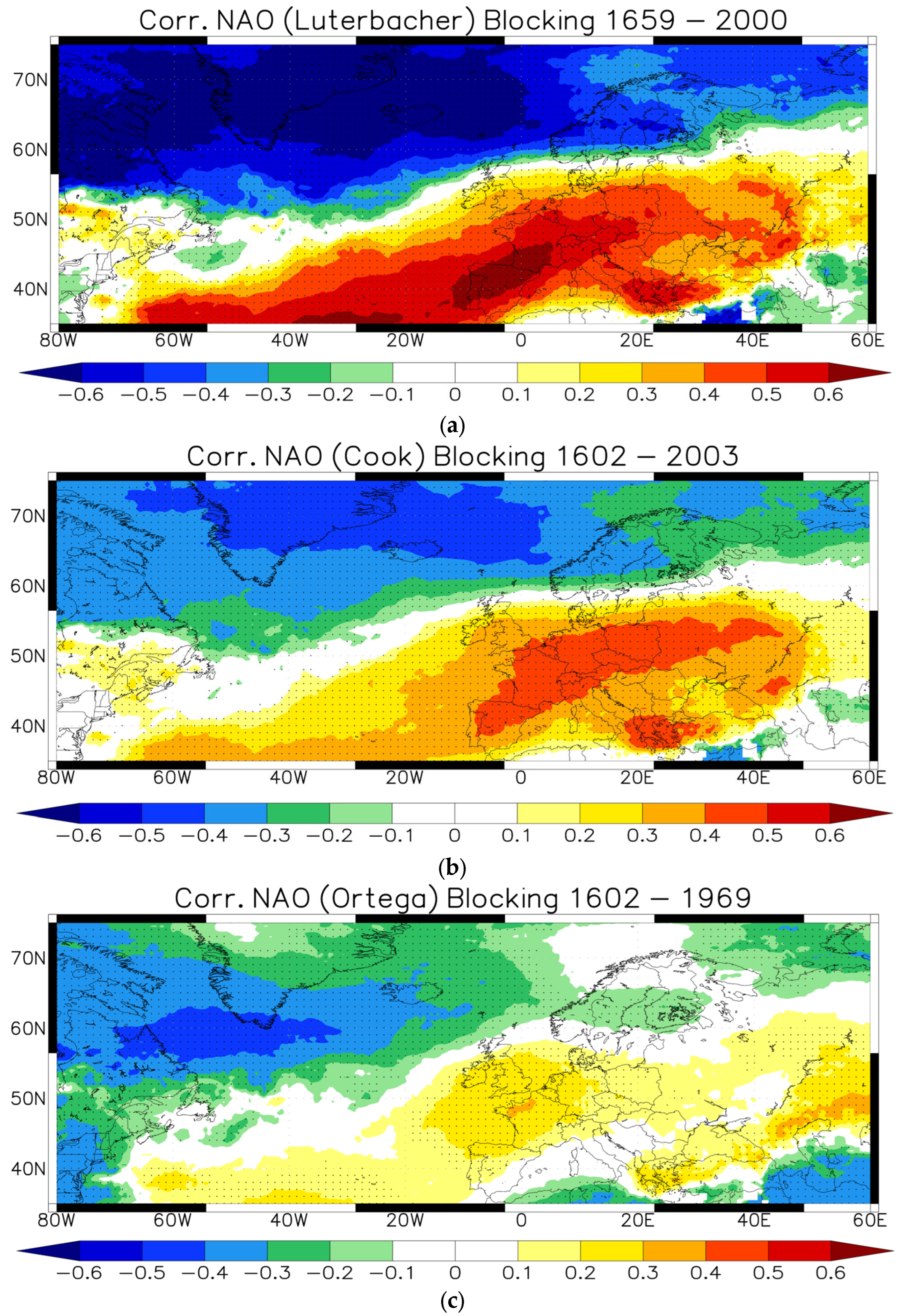
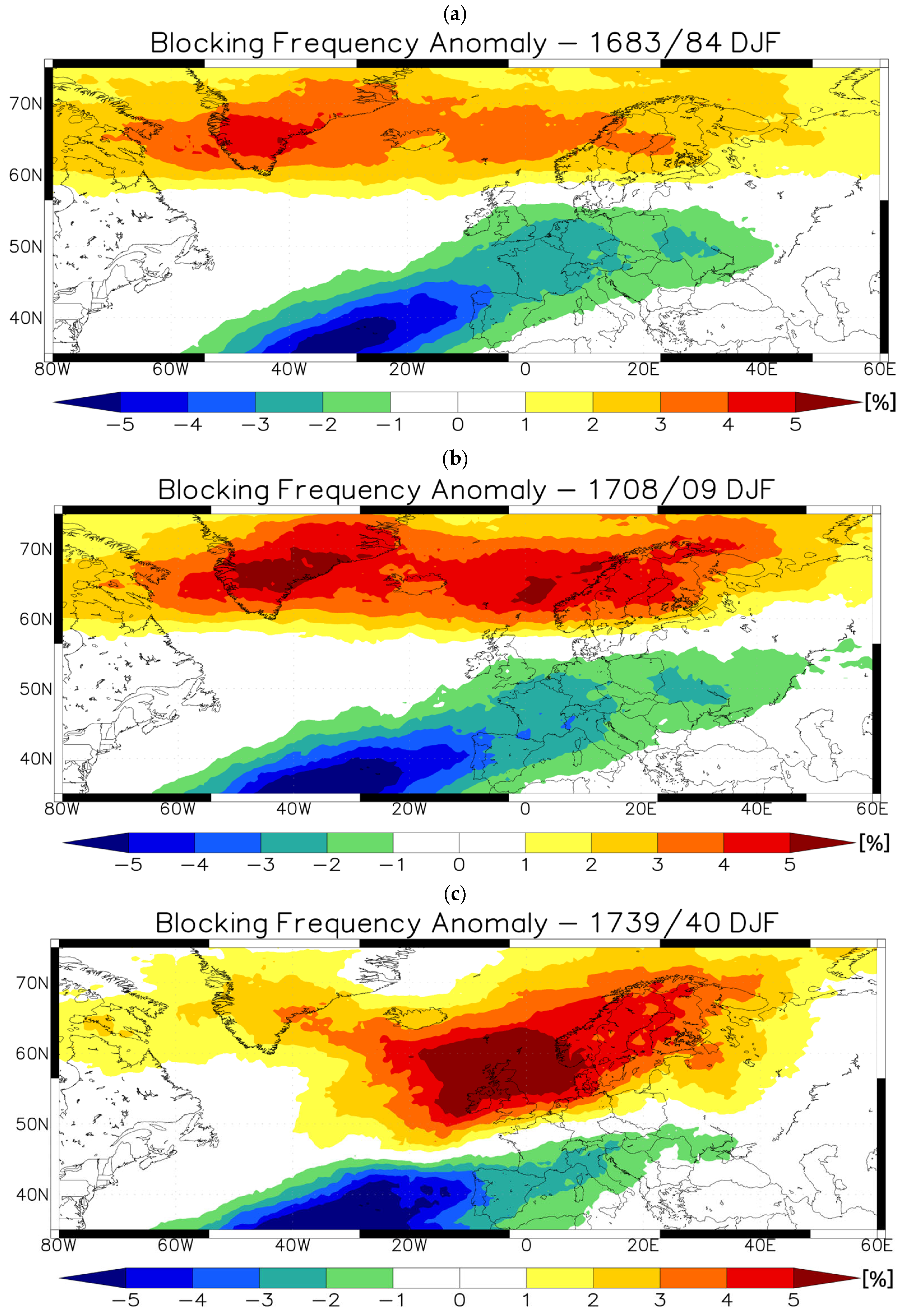
Disclaimer/Publisher’s Note: The statements, opinions and data contained in all publications are solely those of the individual author(s) and contributor(s) and not of MDPI and/or the editor(s). MDPI and/or the editor(s) disclaim responsibility for any injury to people or property resulting from any ideas, methods, instructions or products referred to in the content. |
© 2025 by the authors. Licensee MDPI, Basel, Switzerland. This article is an open access article distributed under the terms and conditions of the Creative Commons Attribution (CC BY) license (https://creativecommons.org/licenses/by/4.0/).
Share and Cite
Rimbu, N.; Ionita, M.; Spiegl, T.; Lohmann, G. Reconstruction of a Two-Dimensional Blocking Index During the Last Four Hundred Years Using Gridded Temperature and Precipitation Data. Atmosphere 2025, 16, 477. https://doi.org/10.3390/atmos16040477
Rimbu N, Ionita M, Spiegl T, Lohmann G. Reconstruction of a Two-Dimensional Blocking Index During the Last Four Hundred Years Using Gridded Temperature and Precipitation Data. Atmosphere. 2025; 16(4):477. https://doi.org/10.3390/atmos16040477
Chicago/Turabian StyleRimbu, Norel, Monica Ionita, Tobias Spiegl, and Gerrit Lohmann. 2025. "Reconstruction of a Two-Dimensional Blocking Index During the Last Four Hundred Years Using Gridded Temperature and Precipitation Data" Atmosphere 16, no. 4: 477. https://doi.org/10.3390/atmos16040477
APA StyleRimbu, N., Ionita, M., Spiegl, T., & Lohmann, G. (2025). Reconstruction of a Two-Dimensional Blocking Index During the Last Four Hundred Years Using Gridded Temperature and Precipitation Data. Atmosphere, 16(4), 477. https://doi.org/10.3390/atmos16040477




